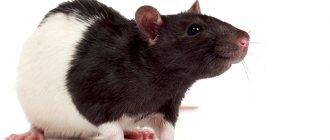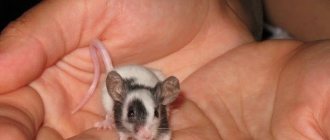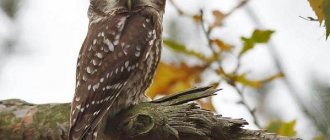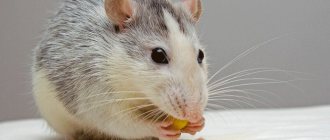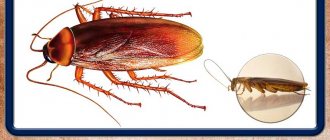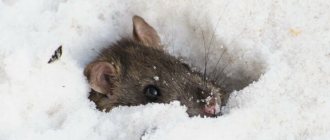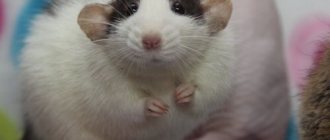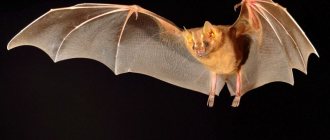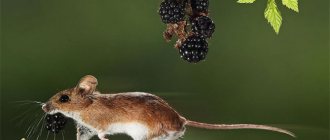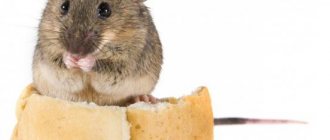The sizes and habits of small rodents belonging to different species of two genera of the mouse family are similar.
To understand and be able to distinguish a vole from a house mouse, let’s compare the appearance and lifestyle of rodents. The differences are more noticeable in the color of the back and the shape of the muzzle.
Distinctive features of field and house mice
The common features of these species are a predominantly gray back and belly, colored light gray.
Field and house mice are found in nature, near homes, living in stacks, attics and warehouses. Both species are carriers of pathogens of a number of dangerous human infectious diseases.
Harvest mouse
External differences of the field mouse:
- Dark stripe on the back and yellowish-brown hairs against a background of dark fur.
- The average body size is 10 cm, tail length is approximately 7 cm.
- The ears are small, pointed, the whole muzzle looks like a triangle.
- The color of the back of the animal from a distance appears golden brown.
The average size of a house mouse is less than 10 cm, with the tail accounting for 60% of the body length. The muzzle is shortened, relatively large ears are round in shape. Males do not differ in size and color from females.
House mouse
The skin of some subspecies of the house mouse is gray-black with a brownish tint, and the abdomen is almost white. Among laboratory animals and pets there are white, yellow, black, bluish-gray individuals.
Field mouse description
To clearly distinguish a field mouse from other relatives, it is important to understand what these rodents look like.
Description of the field mouse:
- The length of its body, excluding the tail, is no more than 12 cm. Moreover, the tail occupies up to 70% of the total length of the body.
- The field rodent has an oblong body. The feet of the hind limbs are elongated. During movement they protrude forward.
- The muzzle is oblong, the ears are small, rounded, and the nose is elongated.
- The fur on the back is quite hard, coarse, and short.
The color of the rodent is varied. The vole can be gray, brown, red or beige. A black or brown stripe runs along the spine. The color of the abdomen is light, close to white. At the base the hairline has a dark tint. Small inclusions are visualized on the thoracic region of some individuals.
The fur changes color depending on the age of the rodent. The older the field animal gets, the lighter its fur becomes. Even the dark base of the fur begins to lighten, and gray hairs appear on individual hairs.
The field mouse has interesting teeth. The pair of mandibular incisors continues to grow throughout the rodent's life. They usually increase by 1-2 mm within 24 hours. For this reason, the mouse is forced to constantly find food or objects on which to grind its incisors.
Field and city mice - similarities and differences
First of all, the field mouse and the city mouse differ in where these animals live. Fieldwort settles mainly in bushes or meadows, and in cities it chooses gardens, parks or cemeteries. The house (city) mouse often inhabits residential premises or outbuildings.
Field rodents are larger in size than urban rodents . In urban animals, only 60% of the total length is on the tail, in contrast to wild animals. Another distinguishing characteristic is the speed of reproduction.
Urban mice produce up to 10 litters per season (3-12 pups each), while field mice produce only 3-4 litters of offspring (3-7 pups per litter).
What does it eat?
The vole consumes both plant (seeds, berries, green parts of plants) and animal (insects) food. Its diet changes dramatically depending on the time of year.
Voles can cause significant damage to both crop storage areas and plants in the fields. They damage vegetables planted in the garden, and also spoil winter preparations that people store in cellars. Once on human territory, this animal gnaws on any food supplies: grain, cereals, legumes, flour, vegetables, fruits, bakery, meat or sausage products.
During the day, a field mouse is forced to find at least 5 g of food. She also needs to drink up to 20 ml of liquid. If there is no access to water, the animal gnaws the succulent parts of plants. Before the coming winter, she begins to make supplies for herself in the summer.
Population of the species and its status
There are about 60 species of voles. A person far from biology cannot distinguish mice by appearance even with a very careful and lengthy examination. A specialist will cope with identification better and faster, but also not always. It is possible to differentiate some species only after studying the results of gene analysis.
Despite their fertility and adaptability to any living conditions, certain species of voles are in danger of complete extinction:
- Vinogradov's lemmings;
- Altai Mole-lepus.
A sharp increase in voles is observed about once every five years, and it is not related to the yield of cereals. Their numbers are reduced after fields are treated with insecticides. But soon the population of pest mice recovers, once again making raids on agricultural land.
field rat
The ground or field rat has nothing in common with ordinary pests and is a mouse type. However, its size is similar to that of ordinary rats. The body length of an adult reaches 25 cm in length and weight up to 0.5 kg. The field rat destroys everything that gets in its way. She likes both cultivated plants and weeds.
If such a pest is infested in the garden, then there is no point in counting on a good harvest. She eats root vegetables and greens, and also likes to wreak havoc on flower beds. This rodent is not repelled by saffron, which has a specific aroma.
Control measures: deratization measures
Sanitary and epidemiological well-being is due to the successful implementation of the entire complex of deratization measures, including organizational, preventive, exterminatory and sanitary educational measures to combat rodents.
Organizational measures include a set of the following measures:
- administrative;
- financial and economic;
- scientific and methodological;
- material.
Preventive measures are designed to eliminate favorable living conditions for rodents and exterminate them using the following measures:
- engineering and technical, including the use of various devices that automatically prevent rodents from accessing premises and communications;
- sanitary and hygienic, including maintaining cleanliness in the premises, basements, and areas of the facilities;
- agro- and forestry engineering, including measures for the cultivation of forests in recreational areas to the state of forest parks and maintaining these areas in a state free from weeds, fallen leaves, dead and drying trees; This same group of activities includes deep plowing of the soil in the fields;
- preventive deratization, including measures to prevent the restoration of the number of rodents using chemical and mechanical means.
The task of carrying out this group of activities lies with legal entities and individual entrepreneurs operating specific facilities and the surrounding territory.
Extermination activities are carried out in populated areas, on agricultural lands, as well as various foci of infectious diseases in order to completely clear objects of rodents and are reduced to the following methods of deratization:
- physical, involving the use of mechanical devices, ultrasonic emitters, glue traps, electrical barriers to destroy rodents;
- chemical, during which rodenticides, rodenticides with synergists in various forms and repellents are used;
- biological, including the use of pathogenic microflora, parasites and predatory animals to destroy rodents.
These events are carried out by legal entities and individual entrepreneurs with special training.
How long do they live?
Field mice do not live long - only 6 months. They become sexually mature after 3 months. Gestation of offspring lasts up to 25 days. The mouse is born blind, without fur, and unable to take care of itself.
The female takes care of the young for 4 weeks, and then the pups move on to adulthood. Then they are forced to arrange their own housing and find food for themselves.
How and with what to fight voles
The field mouse tries to hide from human eyes as much as possible, so fighting them is quite problematic. To get rid of mice in your summer cottage, you first need to find and destroy their nest.
There are various ways to get rid of voles. Experienced summer residents and gardeners offer something new every time.
It is possible to remove and expel a rodent from a plot of land in the following ways::
- Take care of mowing tall grass, collect and dispose of all dry leaves, as well as weeds. If there are piles of garbage or old branches on the site, they also need to be burned or taken to a landfill. It is advisable to do this, since voles like to dig holes in such places.
- If there are many fruit trees growing on the property, it is important to regularly collect fallen, overripe fruits, since they are an easily accessible source of food and attract rodents.
- To get rid of holes and passages dug underground, it is useful to dig up the area.
- To prevent field animals from spoiling fruit trees, it is recommended to dig a fine mesh net around the trunks. It is also useful to do this around the perimeter of the entire site.
It is also appropriate to use ultrasonic repellers. They are usually installed around the perimeter of the land, but care is taken to ensure that moisture does not get into them. Such devices quickly allow you to expel rodents from the garden.
To combat voles, some also use classic mousetraps . Their installation is very justified in the spring and late autumn, since rodents reproduce especially actively at this time. To protect pets from being harmed by a mousetrap, they are covered with a box. And this will not be an obstacle for mice if they smell food.
Sometimes voles not only attack vegetable gardens, but also try to enter living spaces.
To get rid of pests in your home, traditional pest control methods are suitable.:
- Place mousetraps throughout the living space. This method is used with caution if there are small children or pets in the family, since they can get hurt if they are careless.
- Use ultrasonic repellers. These devices are absolutely harmless to households and pets, but mice cannot tolerate ultrasound.
- Buy special store-bought poisons and follow the instructions to distribute them around the house.
- Get a natural enemy of voles - a cat. Rodents are afraid of even lazy felines. If it is impossible to constantly keep a cat, then you can borrow it from friends during the rodent invasion.
The listed methods allow you to quickly get rid of pests both in your garden and in your home. The main condition is to create unbearable living conditions for mice.
In addition, preventive measures are important to protect against re-invasion of mice. They imply maintaining cleanliness of the site, timely removal of plant debris or food waste.
Factors influencing life expectancy
The lifespan of rodents is influenced by various factors, ranging from grain yields to drought.
Mice eat a lot due to their accelerated metabolism, which makes them indispensable for experiments in the laboratory. In order not to weaken, they eat 5 times a day. Rodents drink up to 3 ml of water per day. Due to accelerated metabolism, the lifespan is short. The genetic factor determined the deadline of 3-4 years.
At the same time, in their natural environment, animals live much shorter lives due to harsher living conditions.
Living conditions
Mice quickly adapt to new conditions, which is why they have populated all continents. Rodents tolerate heat and cold well.
To minimize the impact of natural disasters, they huddle closer to their homes:
- A bad year can significantly reduce the population. Lack of food leads to poor development and premature death.
- The availability of water sources is even more important. Mice survive drought more difficult than underfeeding. There are cases where entire populations of rodents in an area died due to the dry season.
- With excess moisture, normal living conditions change. Stagnant water, mold and fungi cause diseases in rodents and shorten their lives.
- Humans affect the lives of all animals, including mice. Sown fields and water supplied to them lead to an increase in population and improved living conditions for each member. Mice love to live near humans. But even on those who live in forests and fields, people have a significant impact; the results of our activities are too large-scale.
Interesting: Mice are the main objects on which scientists are testing ways to prolong life and slow down aging. Small rodents have already managed to dispel many myths about factors that prolong life.
Nutrition
The search for food is a fundamental part of the life of any creature in the wild. A mouse doesn't eat everything like a rat. That is why it is more difficult for her to survive, because mice and rats are neighbors. During times of hunger, when there are no grains, vegetables or leftover food, the rodent may eat leather from furniture or other things.
Animals that live close to humans and have a reliable source of food in cellars, gardens and at home have a longer life expectancy than in the wild. However, they do not live longer than 1.5-2 years.
Threats and risks
The whole life of a small animal is a complete stress. A mouse faces numerous dangers in any habitat:
- Live nature. Mice are hunted by a large number of animals and birds. They are hunted on the ground by foxes, martens, and even wolves. Even a hedgehog can eat a small rodent. They are also food for birds, such as owls. Snakes also eat animals. The ubiquity of their habitat and large population makes mice a convenient food for predators.
- Neighborhood with people. There are many dangers that await animals near humans. They are also hunted - the owners' favorites, cats, are often capable of catching all the mice in the vicinity just for the sake of playing.
Some dogs can also catch mice. Previously, they even bred special breeds that were trained to catch rodents.
The mouse is not an intelligent animal. She is not as smart as a rat, so she easily falls into traps and snares. Chemical agents used by humans against rodents significantly reduce the population.
Interesting: Even representatives of the plant world hunt poor kids. In Java there is an insectivorous plant that, on occasion, can even eat a mouse. It is called Nepenthes spathulata.
Who eats voles
The field mouse is quite prolific and this is very appropriate considering how many natural enemies it has.
Who eats mice:
- birds of prey: owls, hawks, falcons;
- foxes;
- martens;
- caresses;
- ferrets;
- hedgehogs;
- snakes;
- cats.
The weasel is also dangerous for rodents because, thanks to its flexible and narrow body, it can freely penetrate nests and eat baby mice.
How do they winter
There is also a lot of interesting information about how voles spend the winter.
They do not hibernate, but their lifestyle has a number of features:
- Minks are made in shelters or shelters or earthen passages.
- Each burrow reaches 3-4 m in length, and also has from 2 to 4 exits. In this case, one hole necessarily leads to a watering hole.
- The burrows are multi-roomed: one is necessarily allocated for the nest and several for storing supplies for the winter.
- They place storerooms at a depth of 0.5-1 m.
Heavy torrential rains or winter thaws often lead to mass deaths of voles. The water in the burrows freezes, so the animals die.
The field mouse is a rodent that can cause significant harm to humans. To successfully fight them, you need to have a good understanding of the structural features and life cycle of these animals.
Definition of concepts
The field mouse (Apodemus agrarius) is the most common species of the genus of rodents of the same name, numbering 20 species included in 4 subgenera. This is a pest that sometimes causes significant damage to agricultural crops.
The house mouse (Mus musculus) is a species of the genus of the same name. The species itself has 130 subspecies found throughout the world. This species also causes damage to agriculture, but much less than field mice. The main harm they cause to humans is when they eat and spoil food and contaminate it with feces and urine.
In addition, these pests chew furniture, wires, books and clothes. Representatives of the genus Mus are more severe pests for humans. They always live where humans settle, i.e. they are synanthropic animals. Both species are vectors of human diseases. House mice are used in laboratories as model organisms. Since their genome is 80% identical to the human genome, they are used to study the work of genes and methods of treating human diseases.
Important! After a mouse bite, the wound should be washed with running water and soap, then wiped with hydrogen peroxide and lubricated with an antiseptic, such as brilliant green, and go to the emergency room. There you will be vaccinated against rabies and tetanus.
These rodents can be kept as pets. Only the majority of laboratory and ornamental mice are hybrids between subspecies. Artificially bred breeds are less timid and more friendly to humans. A wild rodent caught in the wild will be difficult to tame. A field mouse found in a field can be kept as a pet. Representatives of this species are more relaxed towards humans.
